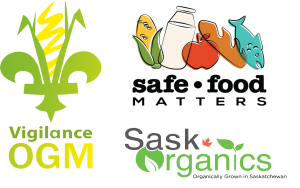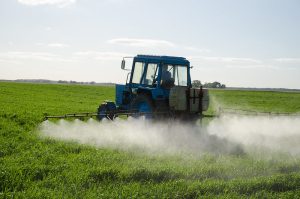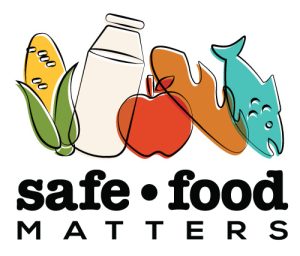“Tractor Fertilize Field Pesticide And Insecticide” by aqua.mech is licensed under CC BY 2.0.
Update: PMRA Transformation Agenda, Increasing MRLs and Action
 Resignations, Increasing MRLs, and Weak Proposals
Resignations, Increasing MRLs, and Weak Proposals
Remember two years ago? It was election time. Health Canada proposed higher levels of Roundup in food at the request of Bayer/Monsanto, the public screamed foul-play, and the government paused the proposal.
A “transformation agenda” was kicked off to fix the Pest Management Regulatory Agency (PMRA), a new team was brought in, and a Science Advisory Committee was established to provide advice to PMRA.
So here we are, two years later, $42 million later, thousands of hours of consulting on the “transformation agenda” later… and what’s the update?
- The Chair of the Science Advisory Committee has resigned, citing an “obsolete regulatory system that protects the pest industry more than it protects Canadians”.
- PMRA is going ahead with increases of pesticides allowed in foods – the “pause” was lifted on June 20, 2023.
- The result of the transformation agenda is a Notice of Intent (NOI) NOI2023-01 for new weak regulations, which do nothing to reduce pesticides, and do everything to maintain the status quo and continue increasing maximum residue limits (MRLs).
Public Comments to NOI
PMRA is accepting public comments on NOI2023-01 until AUGUST 19, 2023. Comments can be submitted by direct email to:
PMRA: pmra.regulatory.affairs-affaires.reglementaires.arla@hc-sc.gc.ca
Cc: Minister of Health: hcminister.ministresc@hc-sc.gc.ca
Please consider ccing one or all of us at:
Comments for Submitting:
There are 4 proposals. They deal with transparency for maximum residue limits (MRLs); access to confidential test data (CTD); letting the Minister ask for available information on cumulative environmental effects (CEE) and for available information on species at risk (SaR).
Here are our specific comments, on the Proposals (not in the NOI order) with further explanations below.
A) Comments on Maximum Residues Limits
The MRL proposal is for PMRA to issue a notice when there is a proposed increase. It still allows the higher level of the “import” MRL to be applied to the levels allowed in Canadian foods. It relies on international data, not Canadian data.
- Canadians want lower risks from pesticides – not a notice that our food may contain more toxic chemicals. Regulations on how to reduce pesticide risks are needed.
- Distinct MRLS are needed for Canadian grown and imported foods. If a type of food is both grown in Canada and imported, then apply the Canadian MRL to both.
- We need checks in the field for compliance with Canadian application/spray labels.
- MRLs should be set using science that is open (not hidden behind unproven “secrecy” claims), relevant, and uses real consumption and field trial data that is Canadian.
B) Comments on Confidential Test Data
The CTD proposal allows for more analysis for “research or re-analysis ” purposes.
- Make it clear that the new permissions are also allowed when inspecting CTD for review and verification purposes, whether or not research or re-analysis occurs.
- When confidential business information and privacy information are “blacked out” or redacted, the legal basis and rationale for such redactions should be set out, and the process for accessing that data should be made clear.
C) Comments on Cumulative Environmental Effects Information
The CEE proposal requires the Minister to consider the cumulative effects on the environment of pesticides that have a common mechanism of toxicity, where available, and gives the Minister explicit authority to require submission of such available information.
- Mandate that the pesticide company obtain and provide the information on cumulative effects from a trusted independent third-party;
- Assess the whole product for cumulative effects, not just the active ingredient;
- Drop the requirement that there be a “common mechanism of toxicity” and focus on the effects instead.
D) Comments on Species at Risk Information
The SaR proposal gives the Minister explicit authority to require the submission of available information on species at risk.
- Mandate that the pesticide company obtain and provide the information on SaR effects from a trusted independent third-party
- Assess the whole product for SaR effects, not just the active ingredient;
- PMRA should also provide explicit regulatory authority relating to assessing harms to the climate and other sectors of the environment including air, water and biodiversity that arise from the use of whole pesticide products.
Explanations for Comments:
A) Maximum Residue Limits (MRLs)
Artificially Inflating Canadian MRLs, No Compliance Checks, Grower Impacts
PMRA thinks the problem is we don’t understand the process for setting “import” MRLs, and so they are providing more “transparency”. PMRA in NOI2023-01 proposes to issue a public notice, for information purposes only, when there is a request to increase import MRLs. It is not clear if the party requesting the increase has to be named. It assumes the reason for the application is to align MRLs internationally.
Except for a new notification, nothing is changing. The way it works now is a pesticide company who wants an increase in pesticide levels points to a type of food grown in another country according to different label directions for how to spray. PMRA approves the high levels for imports of that food. The problem is PMRA then increases the MRL for all foods of that type grown in Canada up to those “import” levels – PMRA assumes all those foods have such levels for purposes of conducting its dietary risk assessment. (DRA).
PMRA says we shouldn’t worry, because when the labels for spraying in Canada are followed, there won’t be high levels on Canadian grown foods. The problem is no one checks on how pesticides are sprayed on the field in Canada, so this is an empty assurance.
PMRA says the levels of pesticides in foods are inspected later by CFIA, and if there are MRL exceedances it means that the labels aren’t being followed correctly and so they follow up. However, the facts are that even when Canadian labels are followed, there can be high levels, as shown by recent Agriculture Canada research. Perhaps one reason is the labels and PMRA assume pesticide levels dissipate overtime, but confidential test data on glyphosate has shown the levels can increase in seed over time. Unless there is someone checking how pesticides are sprayed in the field, there will be no way to fix Canadian labels that are resulting in unexpected, high levels. This increases the risk arising from pesticides.
Additional problems with artificially raising the Canadian MRL is it negatively affects both Canadian farmers and the Canadian organic industry:
- The Canadian grower who wants to use pesticides is at a disadvantage vis-à-vis the farmer in the country that allows higher, more liberal applications of a pesticide.
- The Canadian Organic Standards are tied to the levels at which MRLs are set in Canada – so artificially raising the Canadian MRL causes real problems for the Canadian organic sector. The testing protocol for organic products in Canada is based on 5% of the MRL. Any increase to MRLs in Canada means that organic products will have an increased allowance of pesticides permitted in Canada, but not in other jurisdictions for trade where legal limits for pesticides are often lower. This will have a direct effect on the Canadian organic sector and will only exacerbate loss of organic acres and markets. For organic products and other sectors that rely on markets that are very sensitive to pesticide levels, this presents a significant and direct risk.
The rational solution for these problems is to set separate and distinct MRLs for imported food and foods grown in Canada and to check for compliance in the field with Canadian application labels. We need separate MRLs for Canadian grown and imported foods, and PMRA can perform a DRA using these two MRLs. If a type of food is both grown in Canada and imported, then the Canadian MRL should apply to both. Otherwise Canada will be importing high levels for foods that we don’t allow ourselves, Canadians and PMRA can’t be sure that food grown in Canada has low pesticide levels, and Canadian farmers will not be on a level playing field with the growers in the import country.
Setting MRLs with Closed, Irrelevant, Made-up Science
There are also concerns with how PMRA sets MRLs. In this new infographic, PMRA talks about 3 steps: 1. Protecting health and environment; 2. Examining exposure; 3. Following international guidelines. None of these steps are truly scientific or relate to the Canadian context.
- Protecting health and the environment: consists of “CLOSED SCIENCE” – an examination of toxicology studies on rodents provided by the pesticide industry and a lack of studies on humans. See the resignation letter linked above. We need OPEN science that examines the scientific literature on the effects of pesticide products on people and the environment.
- Examining exposure: this is “IRRELEVANT SCIENCE” on consumption. PMRA uses the DEEM-FCID database, which database measures what Americans, not Canadians eat, and so does not help assess the dietary risks to Canadians. It’s “irrelevant science“.
PMRA’s own policy note shows that Americans and Canadians eat differently – Americans eat more processed foods and Canadians eat more fruits and veggies – and PMRA admits that DEEM-FCID “may not be representative of Canadian intakes“. Yet it still uses this irrelevant data. Relevant Canadian consumption data from the Canadian Community Health Survey is available to PMRA, and is used extensively by other departments, but not PMRA.
- Following international guidelines: this is “MADE-UP SCIENCE“. The MRLs are set using the OECD Calculator, which “overestimates” the highest levels found in field trials with its statistical approach, as explained in the OECD’s White Paper. The field trials aren’t even necessarily Canadian. If an “import” MRL is to be set for a food also grown in Canada, we think the MRL should be set no higher than the Canadian MRL, and for purposes of its DRA PMRA can allocate the import MRL to the proportion of that type of food that is imported vs. grown in Canada. These statistics are available.
International trade organizations set Canadian MRLs
In terms of process, the “international guidelines” are generally the levels set by the OECD, through the Codex Committee on Pesticide Residues (CCPR). The CCPR takes recommendations from the Joint WHO/FAO Meeting on Pesticide Residues (JMPR), which is a collection of adhoc, non-governmental “experts” whose purpose is to harmonize MRLs internationally for trade purposes. The JMPR decides on what data is put into the OECD Calculator.
For the 2021 Proposal to increase glyphosate, which caused the public outcry and “pause”, it was clear the recommended MRLs came from the Ottawa 2019 Extra Meeting of JMPR. At the 2021 CCPR meeting that accepted the glyphosate MRLs, Croplife International, an association of the world’s largest pesticide companies, was represented by 68 people. Canada had 9. Canada had no objections to the increases. (See the Report and Appendix I).
Status Quo
Now that the “pause” has been lifted, Syngenta’s proposal is first up. It uses the same closed, irrelevant and made-up science.
B) Access to Confidential Test Data
The NOI proposes to “enable inspection of CTD for research and re-analysis purposes”. We want clarity that the permissions are allowed when a person inspects the CTD just for review and verification purposes, whether or not the purpose is to re-analyze it or conduct research. Scientific accountability is important.
A further problem is that when confidential business information (CBI) and privacy information are protected, PMRA simply blacks out (redacts) the information and, at best, says “go ask these other departments about how to get at that data”.
PMRA needs to confirm that the redactions align with the legal requirements, instead of just redacting because they are told by the pesticide company that something is CBI or privacy information that cannot be disclosed.
C) “Available” Information on Cumulative Environmental Effects
The NOI 2023-01 proposal is explicit that the Minister of Health is to consider CEE and that he or she has explicit authority to require available information on CEE from the pesticide company. In our view, this proposal is just giving the Minister powers that he or she already has. Plus, there are problems with the wording.
First, it is not clear what “available” means. This is a loophole word, because the pesticide company, who has the onus to prove that the risks from pesticides are acceptable, could just say “we looked around, and no information is available”. The proposal should mandate that the pesticide company get the information when none is available. Given the potential for regulatory capture of PMRA, it would be best if the pesticide company hire a trusted independent third-party to provide the information.
Second, the NOI speaks to considering the cumulative effect of the “pesticide”. Industry and PMRA interpret “pesticide” to mean just the active ingredient in the formulated pesticide product. For example, glyphosate is the ingredient that acts to kill pests, in the product known as Round-up. In the real world, pesticide products are what hit the environment, not “active ingredients”. Pesticide products have additives to make them get absorbed by the plant more easily, and they can be more toxic than even the active ingredient itself, and the combination with the active ingredient can increase ecotoxicity by a factor of up to 100. A cumulative effects assessment should assess the whole pesticide product.
Third, the NOI speaks to assessing pesticides that have a “common mechanism of toxicity”. However, the cumulative effects of pesticides arise from the combination of effects of various pesticides, whether or not they have a “common mechanism of toxicity”. The cumulative effects assessment should focus on the effects, and not on the mechanisms by which the effects are caused. This is also the most appropriate lens through which to view pesticide products, since the additives to products cause effects that are missed when looking only for the “common mechanism of toxicity”, which relates to the active ingredient only.
D) “Available” Information on Species at Risk
The NOI proposal is to give the Minister the explicit authority to require the submission of available information on species at risk. Again, PMRA is adding an “explicit” authority for an authority the Minister already has. And, again, the Proposal uses the imprecise phrase, “available information”.
PMRA also indicates that in the Pest Control Products Act, “environment” encompasses biodiversity and wildlife, including species at risk. However, the definition encompasses other sectors of the environment including the air, water, biodiversity and climate. At a minimum, PMRA should provide explicit regulatory authority for assessing harms to the climate and other sectors of the environment including air, water and biodiversity that arise from pesticide use.
Summary
The NOI 2023-01 proposals allow MRLs to be increased, protect industry data, and maintain the status quo. Despite the rhetoric of the “Transformation Agenda”, PMRA is running an “obsolete regulatory system that protects the pest industry more than it protects Canadians”.
We need a regulatory system that includes independent science, examines the entire product, looks at the actual risks to Canadians and all sectors of our environment, and aims to reduce pesticides. Such a system would protect Canadians, not industry.
This is the transformation Canadians are looking for.


